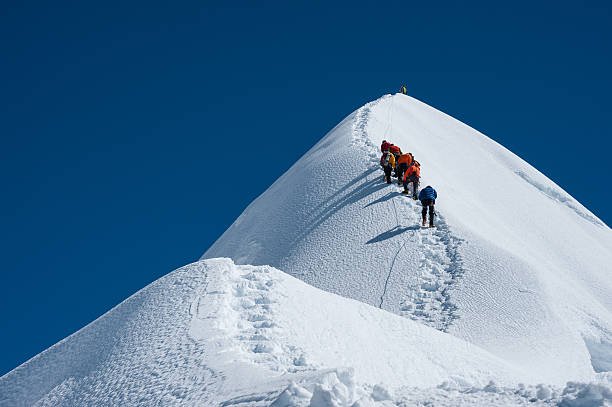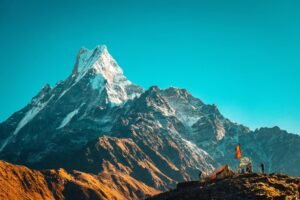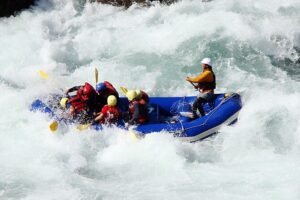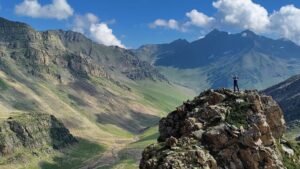The Himalayas, often referred to as the “Roof of the World,” are a formidable and majestic range of mountains that span across five countries: Bhutan, India, Nepal, China, and Pakistan. With their towering peaks, including Mount Everest, the highest point on Earth, the Himalayas have been both a source of inspiration and a formidable challenge to adventurers and explorers throughout history. While many have successfully navigated these rugged terrains, others have faced life-threatening situations that tested their endurance, resilience, and will to survive. This article delves into some of the most harrowing and inspiring survival stories from the Himalayas.
The 1996 Mount Everest Disaster
One of the most infamous survival stories in the Himalayas is the 1996 Mount Everest disaster, which claimed the lives of eight climbers. The tragedy, which unfolded over a few days in May, was the result of a combination of factors including severe weather, human error, and poor decision-making.
The Climb
Several expeditions were attempting to summit Everest during the spring season of 1996. Among them were two guided commercial expeditions led by experienced climbers Rob Hall and Scott Fischer. Both teams faced delays and bottlenecks at the Hillary Step, a crucial point near the summit, which set them back significantly. The congestion on the mountain was a result of the narrow weather window available for a safe summit attempt, which forced multiple teams to ascend simultaneously.
The logistical challenges of coordinating multiple teams, coupled with the physical and mental exhaustion of the climbers, created a precarious situation. As they approached the summit, it became increasingly clear that their window for a safe return was closing rapidly. Despite these ominous signs, many climbers pushed forward, driven by the desire to reach the top.
The Storm
As the climbers descended from the summit, a ferocious blizzard hit the mountain. Visibility dropped to near zero, and temperatures plummeted. Exhausted and disoriented, many climbers were caught in the storm. Rob Hall, who stayed behind to help a struggling client, Doug Hansen, perished on the mountain. Scott Fischer also succumbed to the harsh conditions. The storm’s sudden onset caught many climbers off-guard, leaving them exposed and vulnerable to the elements.
The storm’s intensity created a nightmarish scenario on the mountain. High winds and blowing snow made it nearly impossible for climbers to see or communicate with one another. The extreme cold quickly sapped their strength, and the lack of oxygen at high altitudes compounded their difficulties. Those who were already exhausted from the ascent found themselves fighting for their lives against the relentless forces of nature.
Survival Against the Odds
One of the most remarkable survival stories from this disaster is that of Beck Weathers, an American climber. Left for dead twice in the freezing conditions, Weathers managed to regain consciousness and stumbled back to camp, despite severe frostbite and injuries. His story of sheer willpower and determination is a testament to the human spirit’s resilience in the face of extreme adversity. Weathers’ journey back to camp was nothing short of miraculous. With his vision impaired by frostbite and his body weakened by the cold, he relied on his inner strength and an unwavering will to survive.
Beck Weathers’ ordeal began when he lost his vision due to high-altitude retinal hemorrhaging, a condition exacerbated by the extreme altitude. Unable to see, he decided to wait for his fellow climbers to return from the summit and guide him down. However, the storm struck, and the group was forced to abandon him. Weathers lay in the snow, slipping in and out of consciousness, as the cold tightened its grip on him.
After hours of lying in the freezing cold, Weathers miraculously regained some strength and began to move. With a determination fueled by thoughts of his family, he managed to stagger back towards the camp. His return was a beacon of hope for the others who were still struggling against the elements. The rescue efforts that followed involved incredible bravery and coordination, as fellow climbers and Sherpas risked their lives to bring him and others to safety.
The 2015 Nepal Earthquake
On April 25, 2015, a massive earthquake measuring 7.8 on the Richter scale struck Nepal, triggering avalanches in the Himalayas, including one that devastated the Everest Base Camp. The earthquake claimed nearly 9,000 lives and left hundreds of thousands homeless.
The Avalanche at Everest Base Camp
The avalanche triggered by the earthquake swept through the Everest Base Camp, killing at least 22 people and injuring many others. Climbers and Sherpas were caught off-guard as a massive wall of snow, ice, and debris descended upon the camp. The force of the avalanche was so immense that it flattened tents and buried climbers under layers of snow.
The scene at Everest Base Camp was one of chaos and destruction. The once bustling camp, filled with climbers preparing for their summit attempts, was transformed into a disaster zone. Survivors described the deafening roar of the avalanche and the terror of being buried under the snow. Many were trapped in their tents, struggling to breathe as the snow pressed down on them.
The Aftermath
In the chaos that followed, survivors banded together to search for the injured and the missing. Many were airlifted to safety by rescue helicopters in a series of daring and dangerous operations. Among the survivors was American climber Jim Davidson, who documented his experience and the rescue efforts in his book, “The Next Everest.”
The rescue operations were a testament to human solidarity and courage. Despite the immense risks, rescue teams worked tirelessly to locate and extract survivors. Helicopter pilots performed dangerous maneuvers in high-altitude conditions to evacuate the injured. Climbers with medical training provided first aid and comfort to those in need. The global mountaineering community rallied to support the survivors and honor the memories of those who were lost.
Jim Davidson’s account provides a detailed and emotional narrative of the disaster and the subsequent efforts to rebuild and recover. His story highlights the resilience of the human spirit and the strength of the mountaineering community in the face of tragedy.
Nanda Devi Unsolved Mystery
The Nanda Devi, India’s second-highest peak, has a mysterious and haunting history. In 1965, a team of American and Indian climbers, under a covert operation by the CIA, attempted to place a nuclear-powered monitoring device on the summit to spy on Chinese nuclear tests. The mission, however, ended in failure, and the device was lost in the mountain, never to be recovered.
The Climbers’ Plight
In 1965, a severe snowstorm struck the expedition, forcing the team to abandon their mission and descend rapidly. The storm was so intense that it scattered the team, and they had to fight their way back to base camp individually. Miraculously, all the climbers survived, but the nuclear device remained lost on the mountain, posing a potential environmental threat.
The mission to Nanda Devi was shrouded in secrecy, and the climbers faced immense challenges. The harsh weather, treacherous terrain, and the weight of the equipment made the ascent incredibly difficult. When the storm hit, the climbers were forced to abandon their carefully laid plans and focus solely on survival.
The decision to leave the nuclear device on the mountain was not taken lightly. The team knew that retrieving it would be nearly impossible under the circumstances. Their descent was a desperate race against time, as they navigated through blinding snow and bone-chilling cold. The story of their survival is a testament to their skill, determination, and ability to adapt to rapidly changing conditions.
Surviving Altitude Sickness
Altitude sickness is one of the most common and dangerous challenges faced by climbers in the Himalayas. The story of renowned mountaineer Ed Viesturs highlights the perils and the necessary precautions of high-altitude climbing.
Ed Viesturs’ Experience
In 1989, while attempting to summit Kangchenjunga, the third-highest peak in the world, Viesturs’ climbing partner developed severe altitude sickness. They were at an altitude of over 8,000 meters (26,247 feet) with no possibility of a quick descent. Viesturs made the difficult decision to administer emergency treatment and stay with his partner overnight, despite the freezing temperatures and thin air.
The onset of altitude sickness can be rapid and debilitating. Symptoms include headaches, nausea, dizziness, and shortness of breath. In severe cases, it can lead to life-threatening conditions such as high-altitude cerebral edema (HACE) and high-altitude pulmonary edema (HAPE). Viesturs’ partner was suffering from HAPE, which required immediate intervention.
The Rescue
The next morning, Viesturs’ partner showed signs of improvement, and they began their slow descent. The ordeal took a toll on both climbers, but their training and preparation for such emergencies proved crucial. They made it back to base camp safely, a testament to the importance of experience, quick thinking, and preparedness in surviving high-altitude sickness.
Ed Viesturs’ decision to stay with his partner, despite the personal risk, underscores the importance of teamwork and loyalty in mountaineering. Their successful descent was a result of meticulous planning, effective communication, and the ability to remain calm under pressure. Viesturs’ experience serves as a valuable lesson for climbers about the dangers of high altitude and the critical need for proper acclimatization and emergency preparedness.
The 2014 Annapurna Avalanche
Annapurna, one of the deadliest mountains in the world, claimed 43 lives in 2014 when an avalanche struck the trekking route. This disaster is one of the worst in Nepal’s climbing history.
The Avalanche
On October 14, 2014, heavy snowfall triggered an avalanche and blizzard that swept through the popular Annapurna Circuit trekking route. The sudden onset of the storm left many trekkers and guides unprepared and stranded at high altitudes. The avalanche, combined with the blizzard, created a deadly combination that took the lives of many and left others fighting for survival.
The Annapurna region is known for its stunning beauty and challenging terrain. The trekking route attracts thousands of adventurers each year. However, the unpredictable weather and the risk of avalanches make it a perilous journey. The 2014 disaster was a stark reminder of the mountain’s unforgiving nature.
The Heroes
Local guides and climbers played a crucial role in the rescue operations. Despite the hazardous conditions, they risked their lives to search for survivors, provide first aid, and guide them to safety. Many stories emerged of trekkers who survived by huddling together for warmth and rationing their limited supplies until help arrived.
The efforts of the local guides and climbers were nothing short of heroic. They navigated through deep snow and treacherous terrain to reach stranded trekkers. Their knowledge of the area and experience in handling emergencies were invaluable in the rescue efforts. Many trekkers owe their lives to the bravery and selflessness of these local heroes.
One of the survivors, a Canadian trekker named Andrew Brash, described how he and his group managed to survive by creating makeshift shelters and rationing their food. They were eventually rescued by a team of local guides who braved the storm to reach them. Brash’s story highlights the importance of preparation, resourcefulness, and the critical role of local expertise in surviving such disasters.
The Sherpas: Unsung Heroes of the Himalayas
No discussion of Himalayan survival stories would be complete without acknowledging the incredible contributions of the Sherpas. These indigenous people of the Himalayas have an unparalleled knowledge of the mountains and are essential to the success and safety of countless expeditions.
Tenzing Norgay’s Legacy
Tenzing Norgay, who, along with Sir Edmund Hillary, was the first to summit Mount Everest in 1953, remains an iconic figure in mountaineering history. His skills, strength, and unwavering spirit set the standard for Sherpas who followed. Norgay’s achievement was a milestone in the history of exploration and demonstrated the critical role of Sherpas in high-altitude climbing.
Norgay’s legacy lives on through the countless Sherpas who continue to support climbers on their quests to conquer the Himalayan peaks. Their intimate knowledge of the terrain, weather patterns, and climbing techniques makes them indispensable partners in these challenging endeavors. The Sherpas’ contributions extend beyond physical support; they are also cultural ambassadors who share their rich heritage and traditions with climbers from around the world.
The 2014 Everest Avalanche
On April 18, 2014, a massive avalanche on the Khumbu Icefall killed 16 Sherpas, making it one of the deadliest days in Everest’s history. The tragedy highlighted the risks that Sherpas take to support climbers. In the aftermath, the climbing community rallied to provide support for the families of the fallen Sherpas and to advocate for better safety measures and compensation.
The Khumbu Icefall is one of the most dangerous sections of the Everest ascent. The constantly shifting ice creates a labyrinth of crevasses and seracs, posing a significant risk to anyone traversing it. The 2014 avalanche was a stark reminder of the inherent dangers faced by Sherpas as they guide climbers through this treacherous terrain.
The loss of 16 Sherpas was a devastating blow to their families and the mountaineering community. It sparked a global conversation about the safety and welfare of Sherpas, leading to increased efforts to improve their working conditions and provide better compensation and insurance coverage. The tragedy also underscored the need for climbers to recognize and respect the invaluable contributions of Sherpas to their expeditions.
The Himalayas, with their breathtaking beauty and daunting challenges, continue to attract adventurers and climbers from around the world. The stories of survival in these majestic mountains are a testament to human endurance, resilience, and the indomitable will to overcome the harshest of conditions. From the tragic events of the 1996 Mount Everest disaster to the bravery of Sherpas who risk their lives daily, these tales inspire awe and respect for those who dare to venture into the “Roof of the World.”
Each survival story is a unique blend of courage, determination, and the human capacity to persevere against all odds. They remind us of the inherent risks of exploring these majestic mountains and the profound respect we must have for nature’s power. The Himalayas will continue to be a place of both peril and profound beauty, where the spirit of adventure meets the limits of human endurance.





